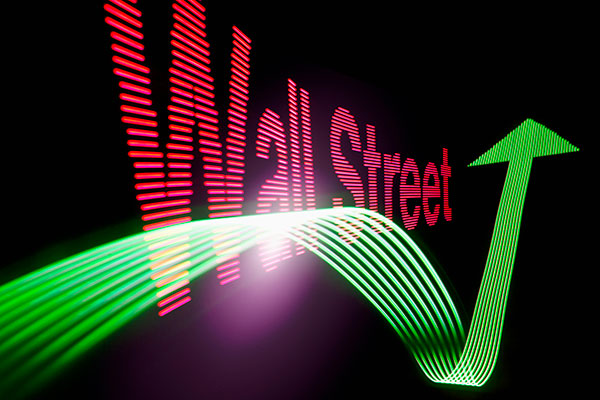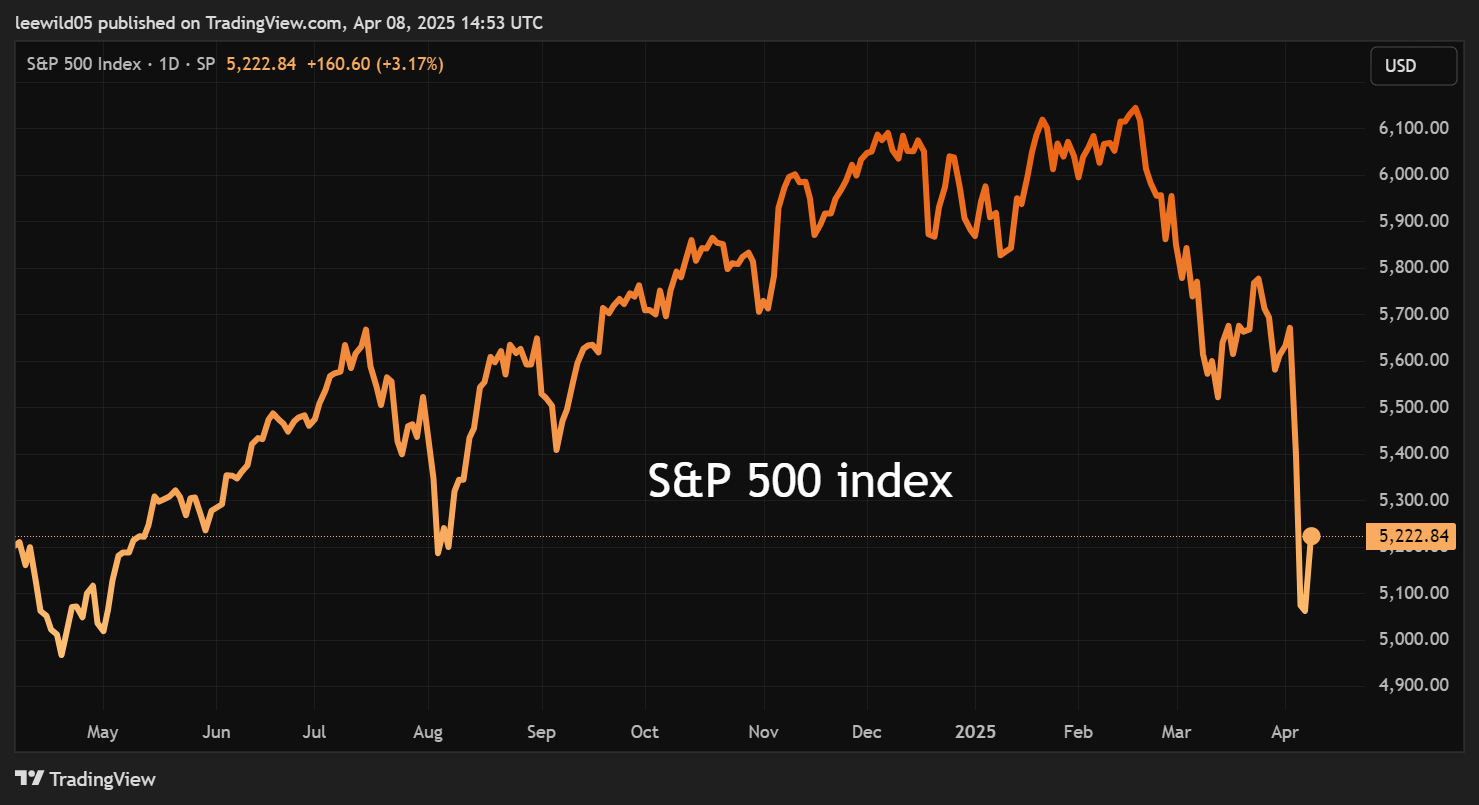The US stocks leading Wall Street’s fightback
Traders in the US woke up in a better mood, taking advantage of one of the stock market’s most dramatic slumps in modern history. Graeme Evans reveals what investors have been buying.
8th April 2025 16:14

Buyers returned to Apple Inc (NASDAQ:AAPL) shares today after they lost almost a fifth of their value as the hardest hit of the Magnificent Seven during Wall Street’s Liberation Day tariffs sell-off.
The key role that China and other Asian countries play in the supply chain for iPhones, MacBooks and other hardware meant Apple closed last night at its lowest level since May 2024.
- Invest with ii: Most-traded US Stocks | Buying US Shares in UK ISA | Cashback Offers
Tesla Inc (NASDAQ:TSLA) shares also fell 17% in the three sessions since Wednesday night, while NVIDIA Corp (NASDAQ:NVDA) shed in the region of 12% amid fears over cost pressures from higher semiconductor import prices.
All three stocks rallied between 3% and 6% at Tuesday’s opening bell, having also drawn strong interest from interactive investor customers during the period of heavy selling on US markets.
10 most-bought UK stocks on the ii platform during the crash
|
1 | |
|
2 | |
|
3 | |
|
4 | |
|
5 | |
|
6 | |
|
7 | |
|
8 | |
|
9 | |
|
10 |
*purchases on the three trading days 3-7 April
The S&P 500 index put back 3% in early dealings, reversing some of the 10.3% slide during the worst three-day performance since the height of the pandemic turmoil in March 2020.
Today’s advance takes the benchmark further away from bear market territory after initially being 4.7% lower on Monday.

Source: TradingView. Past performance is not a guide to future performance.
Yesterday’s recovery came even though the VIX index of volatility jumped to 46.98 points by the close, its highest level since the start of the pandemic as comments by President Trump pointed towards a tit–for-tat escalation of the China trade war.
The index fell back to below 40 points during today’s session - still much higher than last week’s level - as traders reflected on renewed hopes that the White House can reach deals with major exporters including Japan.
- Stockwatch: Buffett, Trump, China and trading tactics
- The Income Investor: FTSE 100 income appeal amid the chaos
- When markets fall, here’s what to avoid doing
Leading financial stocks were also sharply higher today, having slumped in previous sessions due to the darker US economic outlook and uncertainty ahead of Friday’s start of the first-quarter results season.
The Goldman Sachs Group Inc (NYSE:GS) fell 16.5% and JPMorgan Chase & Co (NYSE:JPM) by 13% in the three sessions following the tariffs announcement, while American Express Co (NYSE:AXP) dropped 15% and Visa Inc Class A (NYSE:V) reversed 10%.
The Nasdaq Bank Index stood 27% lower than its 6 February peak, leaving the sector well within the definition of a bear market.
Deutsche Bank pointed out today that since 1966 there have been 29 bear markets when on average bank stocks have declined 30% during these periods.
Today’s recovery helped the US economy-focused Dow Jones Industrial Average put back about 3%, in line with the early performance of the Nasdaq Composite.
The rest of the Magnificent Seven traded higher, including Amazon.com Inc (NASDAQ:AMZN) in the wake of an 11% fall in the previous three sessions.
UBS said earlier today that the near-term outlook for AI and technology is challenged, with rules around tariffs and exemptions still not clear at a company level.
- Sign up to our free newsletter for share, fund and trust ideas, and the latest news and analysis
- How investors can hedge against Trump’s trade wars
It expects IT companies to offer tepid outlooks in the upcoming earnings season and that hyperscalers’ investment in AI infrastructure may also be at risk if core cloud revenues decelerate. However, it adds that the longer-term drivers remain firmly intact.
UBS also points out that global tech stocks are tracking the 20%-plus correction witnessed in 2018, when sentiment was also hit by significant tariff escalation.
Global tech earnings were revised down by 12% during that period, showing that negative revisions due to tariffs and resulting macroeconomic uncertainty are not new for tech.
UBS said: “What is interesting is how tech stocks rebounded once the tariff uncertainty diminished on policy updates and as investors started to recognise the strong structural growth prospects of the cloud theme.
“After a peak-to-trough decline of about 24%, tech stocks rebounded by more than 30% over the next 12 months with lower rates also fuelling strong gains.
- Investors decide it’s time to buy these FTSE 100 stocks
- Is it still worth investing in American stocks?
The trends highlight the importance of staying invested during times of market turmoil.
On the 12 occasions since 1945 when the S&P 500 fell by 20% from its peak, UBS said the index delivered positive returns 67% of the time over the subsequent year - with an average return of 12.9%.
This rises to 91% over three years with an average return of 29.2% and 100% over five years with an average return of 52.7%.
UBS added: “Staying invested also reduces the risk of missing significant "up days" for financial markets, which often occur during periods of high volatility. The 7% intraday swing in the S&P 500 on Monday demonstrates the potential costs of selling at the wrong time.”
Schroders head of strategic research Duncan Lamont added: “The simple reality is that the stock market has tremendous power to help grow wealth in the long-run but short-term volatility and risk of falls are the price of the entry ticket.”
These articles are provided for information purposes only. Occasionally, an opinion about whether to buy or sell a specific investment may be provided by third parties. The content is not intended to be a personal recommendation to buy or sell any financial instrument or product, or to adopt any investment strategy as it is not provided based on an assessment of your investing knowledge and experience, your financial situation or your investment objectives. The value of your investments, and the income derived from them, may go down as well as up. You may not get back all the money that you invest. The investments referred to in this article may not be suitable for all investors, and if in doubt, an investor should seek advice from a qualified investment adviser.
Full performance can be found on the company or index summary page on the interactive investor website. Simply click on the company's or index name highlighted in the article.
Editor's Picks